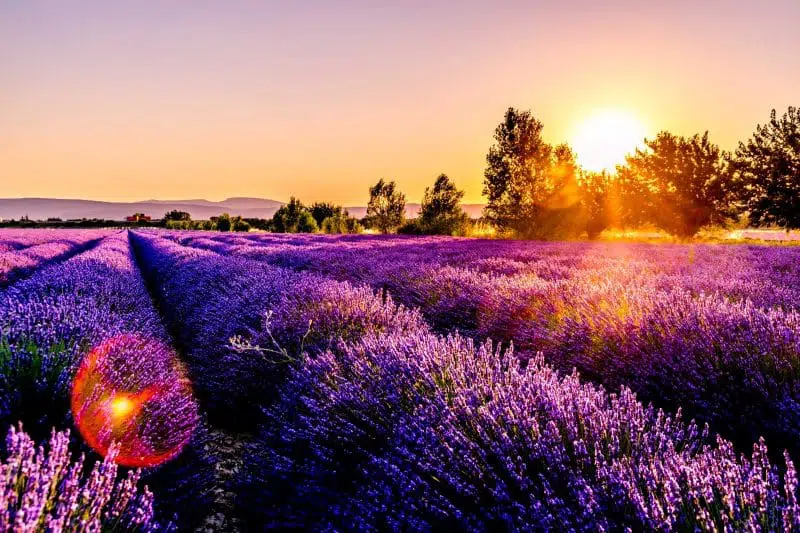Bonjour to the Animals and Wildlife in France!
France is renowned for its beautiful scenery, cities, food, and champagne! But did you know that France is also home to many beautiful animals and wildlife?
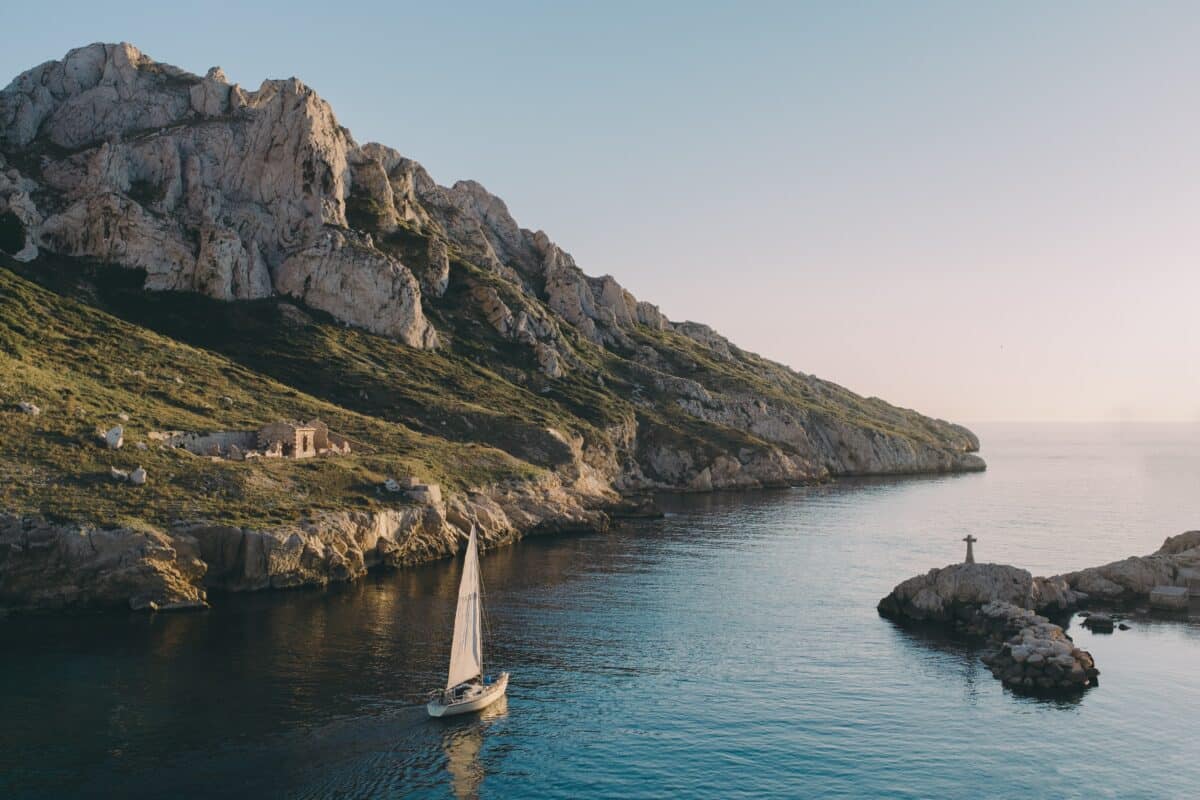
Wildlife in France is discrete and unique, and this blog will pinpoint a few exciting animals which you may want to watch when you’re next visiting the stunning country!
Key Points
| Wildlife | Description | Distribution | Diet | Behavior and Habits | Conservation Status |
|---|---|---|---|---|---|
| South Genets | – Closely related to mongooses and civets. – Carnivorous, feeding on insects, small rodents, and birds. – Nocturnal and elusive. – Native to Africa. | – Native to Africa, introduced to Spain and southwest France in the 12th century. – Two species exist in Europe. – Rarely seen outside of captivity. | – Primarily eat small mammals, birds, mollusks, and insects. – Can consume vegetation but it’s a minor part of their diet. – Excellent climbers and swimmers. | – Nocturnal and elusive, sleeping in tree holes or hollows during the day. – Mostly positive relationship with humans as they help control rodent populations. | Least Concern |
| Green Lizards | – Reach up to 40 cm in length. – Males are green with black and lemon yellow speckles. – Females have yellowish lines down the back outlined with black specks. – Prefer dense, bushy habitats with sunlight. | – Restricted to regions below latitude 49° in France, mainly south of the Seine. – Absent from Corsica. – Favor areas with dense, bushy habitat. | – Diet consists of insects, butterflies, fruits, small mammals, birds’ eggs, and baby birds in nests. – Superb climbers. – Can sometimes be indifferent to human presence. | – Excellent climbers in trees, bushes, and stone walls. – Diet mainly comprises insects and butterflies. – Not dangerous to humans. | Least Concern |
| Chamois | – About 75-80 cm tall and weigh up to 60 kg. – Excellent climbers. – Short, curled horns. – Black stripes under the eyes. – Change coat color with the seasons. | – Prefer lower regions but are forced higher up due to human presence. – Have been reported near the summit of Mont Blanc. | – Primarily herbivores, feeding on grasses, seeds, flowers, and even tree bark in winter. – Need to adapt to seasonal food availability. – Excellent climbing and gripping abilities. – Lives up to 25 years. | – Form herds, except for males who are solitary except during mating. – Prefer lower regions but go higher due to human presence. – Able to adapt to seasonal food availability. – Noted for climbing and gripping skills. | Least Concern |
| The North Wolves | – Grey wolves returning to northern France for the first time in a century. – Likely a young male in search of a mate. | – Wolves re-established in France about thirty years ago, mainly in the Alps and the southeast. – Lone wolf sighting in Seine-Maritime in northern France. | – Omnivorous but primarily eat small mammals. – Increased numbers have led to protests from farmers. – Wolves are a protected species under EU law. | – Wander over long distances before settling. – Sightings of wolves in northern France were rare. – Increasing numbers have led to protests from farmers. | Least Concern |
| Wild Boars | – Population rapidly growing due to climate change, food availability, and lack of hunting during confinement. – Cause damage to agriculture. | – Mainly found in the Occitanie region, especially in Hautes-Pyrénées, Gers, and Gard departments. – Expanding closer to urban areas. | – Omnivorous, primarily feeding on crops, grains, and occasionally fruits. – Mothers can have multiple births every two years, increasing population. – Cause significant damage to agriculture. | – Population growing due to climate and food availability. – Hunting ban during confinement led to further population growth. – Getting closer to urban areas. – Cause damage to agriculture and property. | Least Concern |
South Genets
Genets share close genetic ties with other small animals such as mongooses and civets. These carnivorous creatures typically prey on insects, small rodents, and birds, employing their sharp, retractable claws to capture their meals.
Their physical appearance is reminiscent of domestic cats, but with striking leopard-like spots adorning their greyish-brown fur, rendering them distinct and beautiful. Genets sport long, bushy tails that are marked with clear stripes. Their heads are small and pointed, accompanied by relatively large ears.
Genets are elusive creatures, primarily nocturnal in their habits. They tend to seek refuge in tree holes or hollows during the daytime, their concealed coat making them quite challenging to spot. Encountering a genet is considered a rare stroke of luck.
Native to Africa and belonging to the Viverridae family, genets were introduced to Spain and southwestern France in the 12th century by the Saracens. These animals were originally employed to control rodent populations in human dwellings before domestic cats assumed this role.
Species
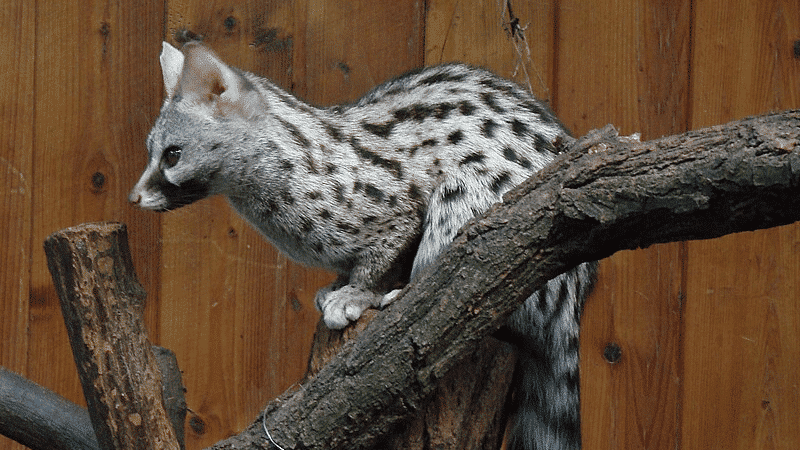
Europe is home to two distinct genet species. The more commonly encountered species is the Genetta genetta, which can be found in regions of western and southern France, as well as the Iberian Peninsula. The other species, G. isabelae, is exceedingly rare and is exclusive to Ibiza, Spain, and the Balearic Islands. Interestingly, G. isabelae is not considered an introduced species due to its historical presence in Europe.
These creatures are truly captivating with their long, slender bodies. They sport a pale grey coat adorned with dark spots across their body, featuring a prominently banded tail that adds to their distinctive appearance. Genets have a pointed face and notably large, pointed ears. They can reach lengths of up to 60 cm, with their tails nearly as long. Despite their striking looks, they are creatures of the night and are quite reclusive around humans. As omnivores, their diet leans more toward meat, with vegetation playing a minor role, much like how cats or dogs might consume it occasionally.
Diet
Their primary diet comprises small mammals, birds, mollusks, and insects. Anything up to the size of a rabbit or squirrel will be taken, but in practice, the bulk of their diet comprises voles and wood mice. They are incredibly agile and excellent climbers. They seem to prefer to be near water, where they are good swimmers. However, they will also be found in arid habitats.
They are present in most of the western half of France, with the possible exception of west Brittany. Furthermore, they are generally found in wooded areas, often where water is present, where they occupy a territory of about 5 square kilometers, using a hole or cavity in an old tree, rock face, or something similar for cover.
They tend to use toilet areas, where excrement will be found in heaps, a helpful indication of their presence.
Breeding can occur almost any time of the year, but the young are generally born during April / May or August / September, producing 1 to 4 young, two litters a year being possible.
Their relationship with humans is, on balance, a positive one. Although there is a possibility that chickens and ducks may be taken from time to time, their main diet is rodents which helps control numbers.
Populations are not generally threatened, although road building can be disruptive locally, and road kills occur.
Green Lizards
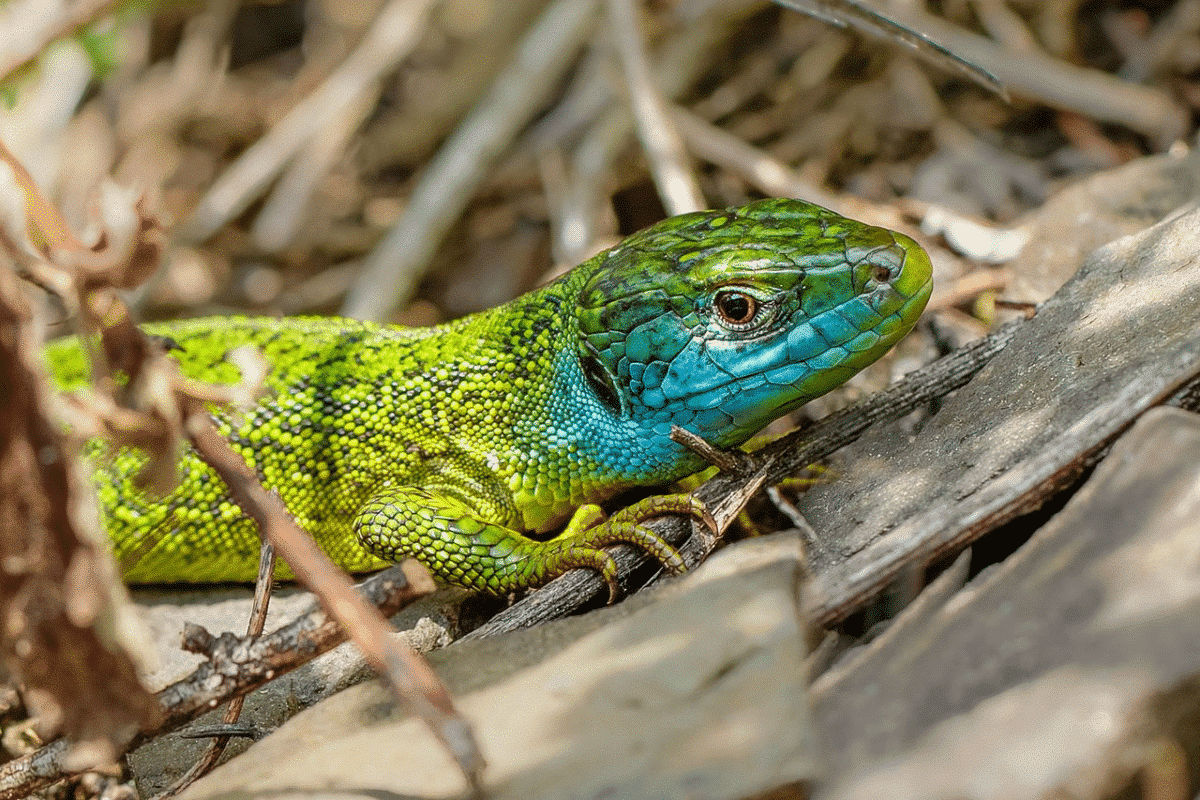
The Green lizard is quite the impressive creature, measuring up to a whopping 40 cm in length! To put that in perspective, it’s longer than your average ruler. This lizard boasts a long tail, which makes up two-thirds of its total length, starting wide at the base and gradually tapering to a cylindrical shape towards the end. It features a sizable, flat head and a rounded nose, with hearing organs positioned at the rear of the head, resembling vertical ovals that match the size of its eyes and are clearly visible.
The lizard’s body is characterized by broad folds or pleats, giving it a distinct appearance. In terms of coloration, the males are predominantly green or brownish-green, adorned with black and lemon yellow speckles. Females, on the other hand, often sport two or four longitudinal yellowish lines running down their backs, accentuated by black specks. During the breeding season, males undergo a vibrant transformation with a blue throat and part of the head, complemented by bright yellow and turquoise on the stomach and the inner legs.
Restricted
They are restricted in France to the regions below latitude 49 ° or generally south of the Seine and are absent from Corsica. Additionally, they prefer areas of a dense, bushy habitat that are not over-managed and have plenty of sunlight; hedges, brambles, and the edges of woods are typical, although scrubby wetlands and similar areas are also favored if there is sufficient cover.
They are superb climbers, whether in trees and bushes or on stone walls, and this is where they catch most of their prey insects and butterflies, although they will also eat fruits, small micro mammals, birds’ eggs, and even baby birds in nests.
They can often completely ignore the presence of humans, yet at other times they will flee a short distance at the slightest movement, where they will often stay and observe you. As with the Oscillated Lizard, they can give quite painful “bites” when handled, but this is not in any way dangerous, not even to a small child.
Chamois
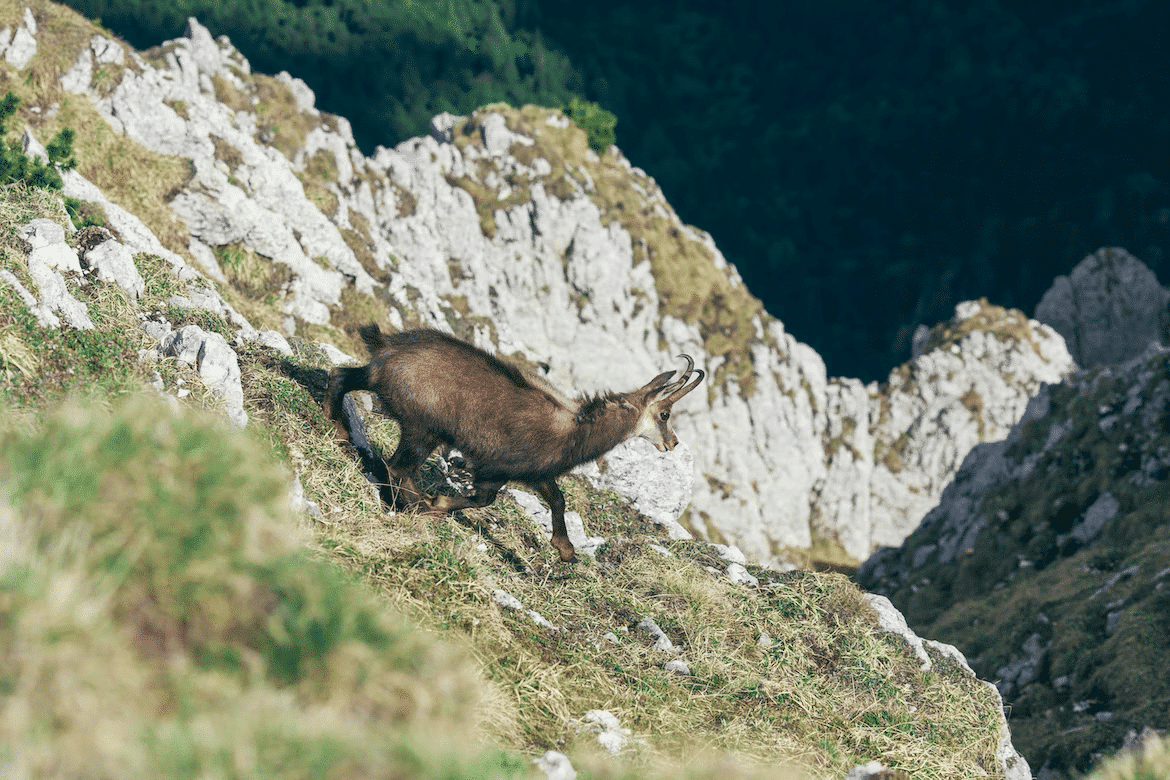
The chamois reach about 75 – 80 cm in height and weigh up to 60 kg. This weight is at the end of summer – during winter. The chamois can lose up to 50% of its body weight. It is very well adapted to the mountain conditions in which it lives. It has excellent climbing abilities, aided by the ability to separate the two ‘toes’ of each hoof. This allows the more extraordinary ability to grip.
The chamois live up to 25 years, although 15-16 is more common. The main factor restricting the lifespan of the chamois is its teeth. They slowly wear out until the chamois can no longer feed effectively.
The chamois is easily recognizable by its distinctive features, which include short, slightly curled horns that it retains throughout the year. It also bears black stripes beneath its eyes, which contrast with its white face. The color of its body hair can vary between grey in winter and brown in summer.
In terms of social behavior, females and young chamois tend to live in herds, while the males are typically solitary except during the mating season. Their diet mainly consists of grasses, seeds, and flowers, although in winter, they may resort to eating even tree bark. Interestingly, chamois prefer to inhabit the lower regions of their habitats, but human presence often pushes them higher up in the mountains.
It’s worth noting that there have been reports of chamois sightings very close to the summit of Mont Blanc, showcasing their remarkable hardiness and climbing abilities, even if common sense might not always prevail. These creatures are a noteworthy part of France’s wildlife.
The North wolves

According to the French Biodiversity Office, a wolf has been seen in northern France for the first time in a century! This is inspiring news. A surveillance camera spotted the lone animal as it wandered through the village of Londinières. This is situated near the French coast in the department of Seine-Maritime.
The prefecture said in a statement that experts from the French Biodiversity Office concluded that it was “very probably” a grey wolf, according to The Telegraph.
Although no wolves remained in France after overhunting in the 1930s, the animals returned to the country thirty years ago – crossing over from Italy.
However, none has been sighted so far north since the species was re-established in the country.
It is thought the lone wolf may be a young male in search of a mate.
Speaking of their movement habits, the Seine-Maritime prefecture said: ”They can cover several hundred kilometers in a few months before settling. The maximum length from the place of birth can exceed 1,500 kilometers (1,350 miles). There are roughly 530 wolves in France today, mostly living in the Alps and the southeast of the country, according to the ONCFS hunting and wildlife agency.
Wolves are a protected species under the EU’s Bern Convention, but the increase in their numbers has led to protests from farmers, who ask for a significant annual cull of wolves. Twelve thousand sheep were believed to have been killed by wolves in France in 2017.
Wild boars
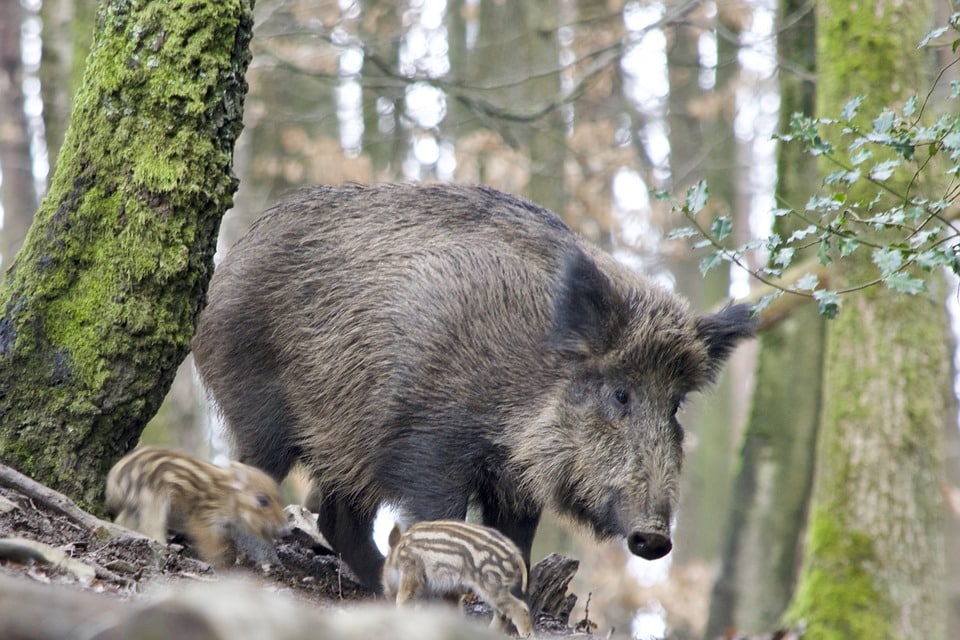
The wild boar population in France has been on a rapid rise, sparking concerns and controversies even prior to the confinement period. Over the past five years, their numbers have swelled to approximately two million. These creatures are predominantly concentrated in the Occitanie region, with hotspots in Hautes-Pyrénées, Gers, and Gard departments.
The effects of climate change and warmer temperatures have resulted in ample food sources for them. Mother boars, known as sows, can give birth up to three times every two years, ensuring more piglets survive the winter and contribute to the population’s rapid growth.
Adding to the challenge, hunting was temporarily banned during the coronavirus lockdown, allowing the wild boar population to continue its expansion. Normally, thousands of these animals meet their fate each year in encounters with trains and cars. However, during the lockdown, there were far fewer such incidents on the railways and roads due to the restricted conditions.
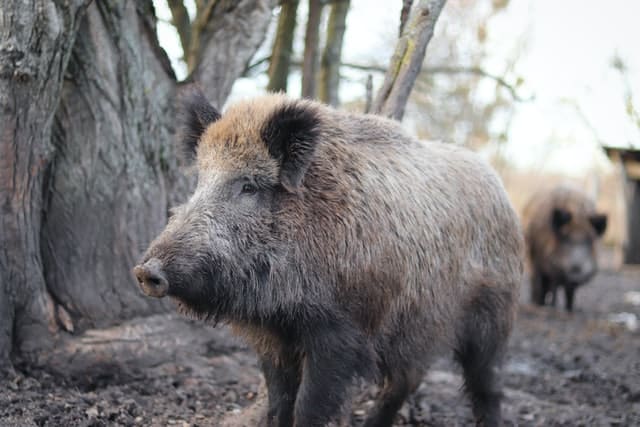
Locals say it is essential to keep the wild boar population down. The animals can cause severe damage to agriculture and property, including wheat crops and other grains. Pine forests often surround these crops. They provide ample shelter, food, and cover for the boar to travel between the Pyrénées-Atlantiques, the Gers, and the Hautes-Pyrénées. The animals are also getting closer and closer to urban areas. They are becoming a more common sight in the Gard, near Nîmes, and even on the outskirts of the Toulouse area (Haute-Garonne).
Summary of Wildlife in France
Based on these five animals alone, it is easy to become excited to discover other Wildlife in France! There are other animals, particularly along the coasts of France, in terms of marine life!
What are you interested in looking out for next time you’re in France? Comment below!
Check out the blogs below for other topics you may be interested in:
Wildlife in Germany, Wildlife in Spain, and Wildlife in Italy.
We hope you enjoyed it! If you’re ever in France and need guidance to find these amazing animals! Thank you for reading Wildlife in France!
Frequently Asked Questions (FAQs)
The red fox (Vulpes vulpes) is one of the most common wild animals in France. It is widespread and adaptable, found in various habitats across the country.
Yes, France has several native animal species, including the European hedgehog, European badger, European roe deer, and European hare, among others.
While Paris is a bustling city, it still has some wildlife. You can find pigeons, sparrows, and other urban birds. Parks like the Bois de Boulogne and Bois de Vincennes are home to various bird species, and the Seine River has fish and occasional sightings of seals.
France is known for several iconic animals, but the rooster (coq) is a symbol of the country and is often associated with France. It’s also known for its French bulldog breed.
- 5 Best Places to See African Wild Dogs - April 24, 2024
- Best Places to See Giant Pandas - April 23, 2024
- Sea Snakes: A Complete Guide - April 23, 2024

